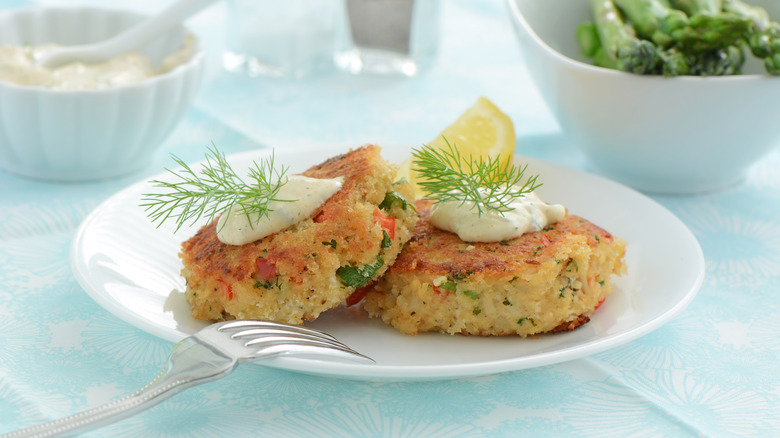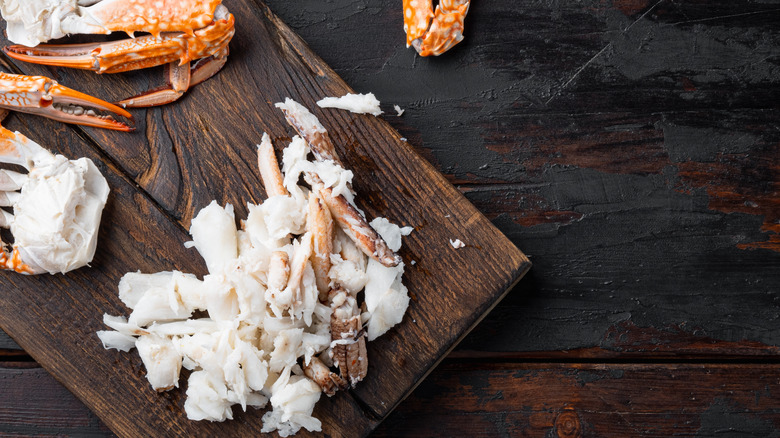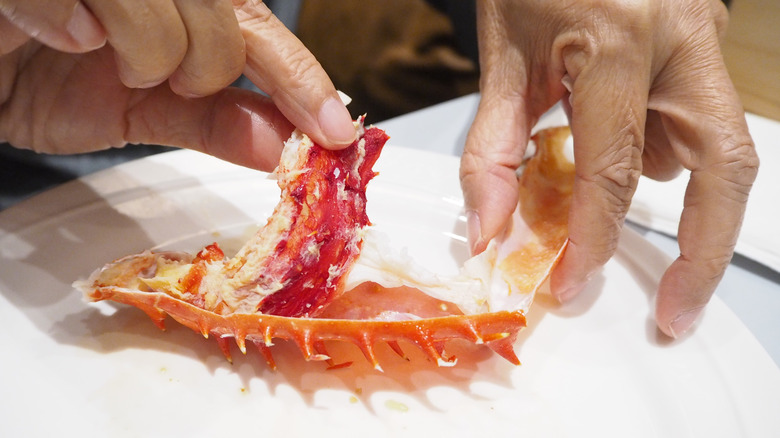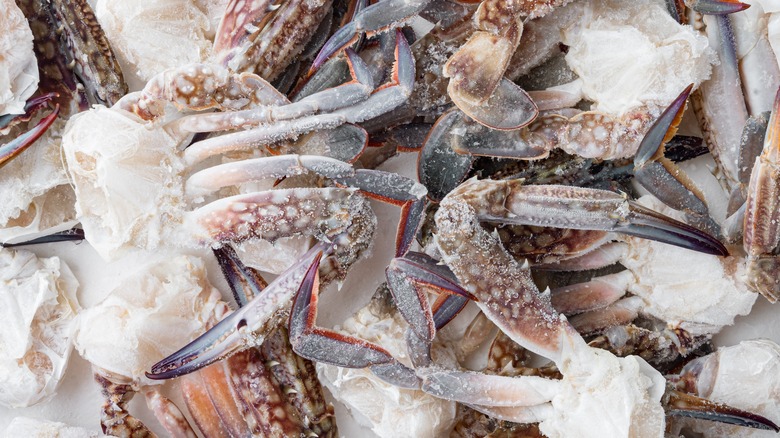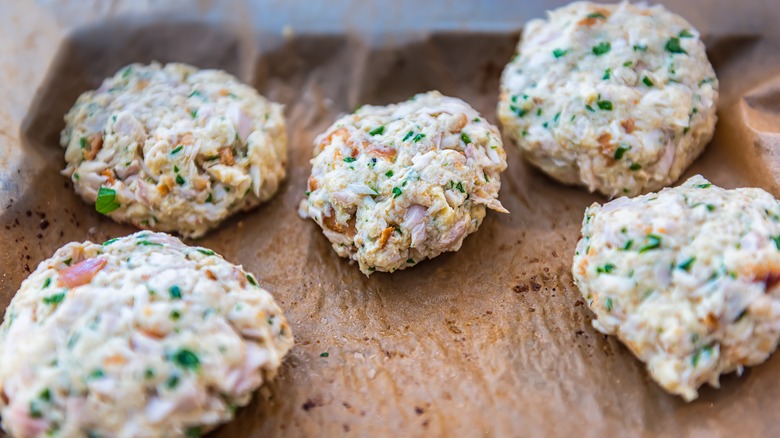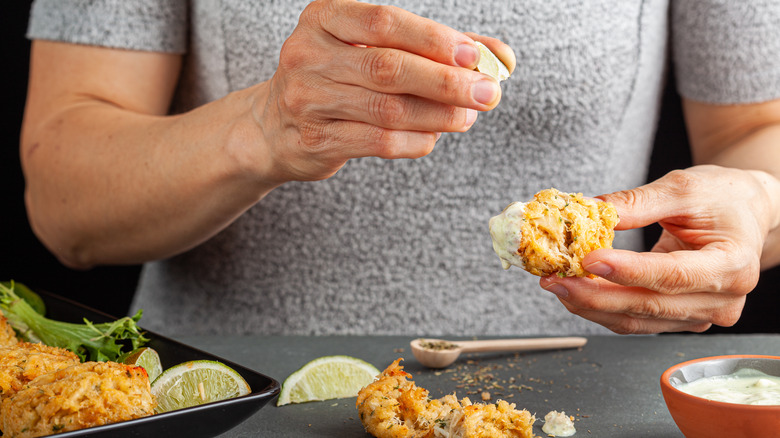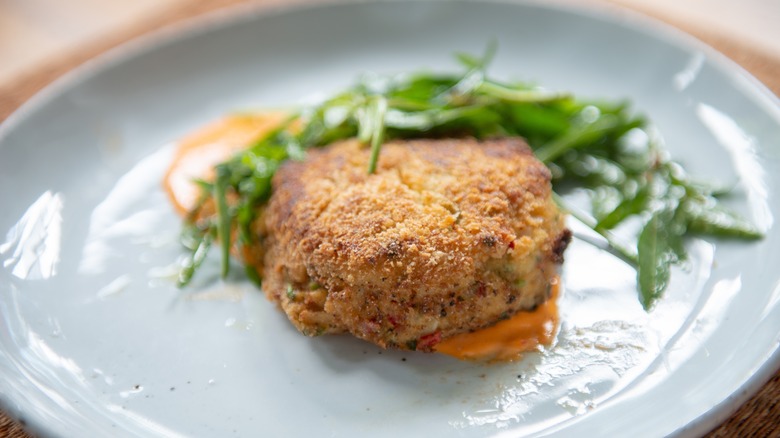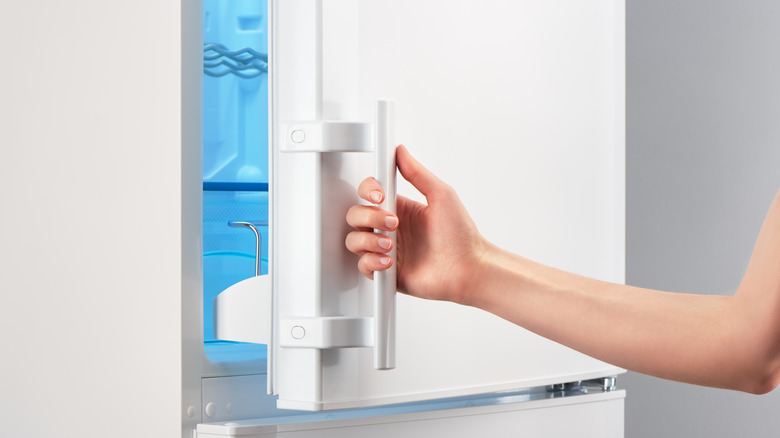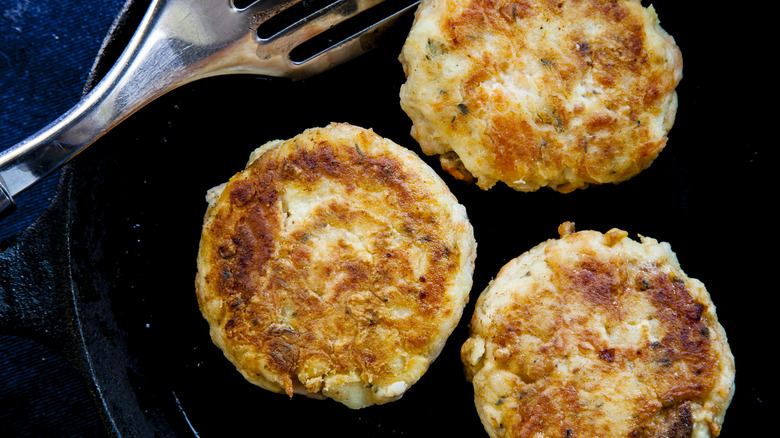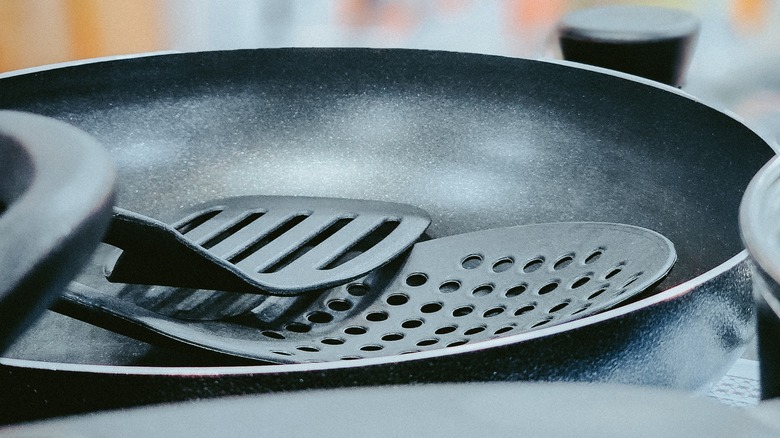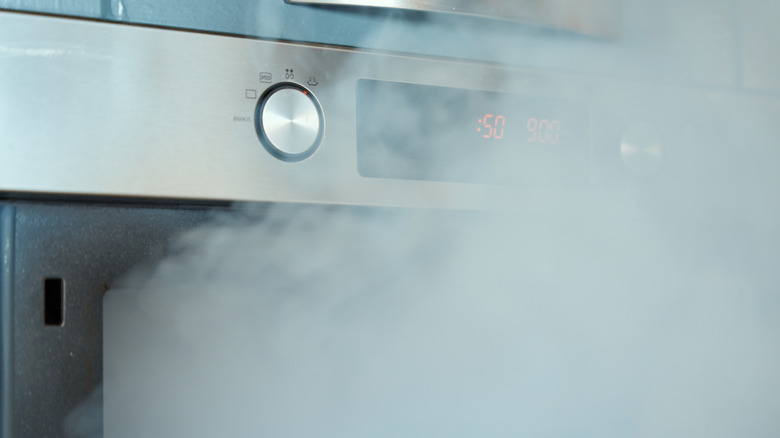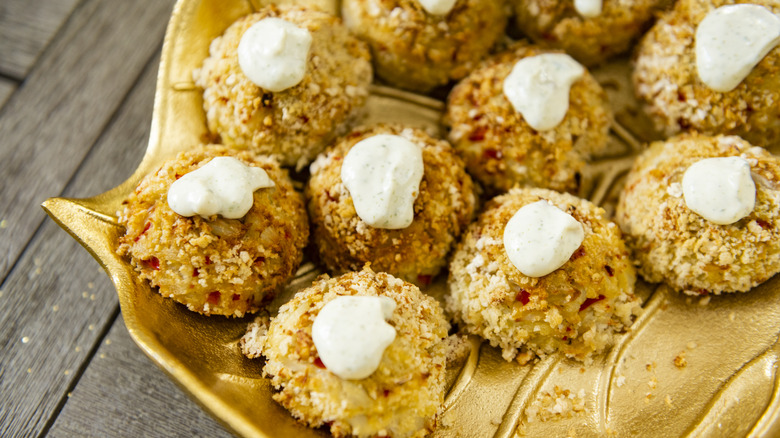Mistakes Experts Say To Avoid When Cooking Crab Cakes At Home
Whether it's a tasty appetizer basket or hors d'oeuvres passed around on a silver platter at a black-tie gala, crab cakes are a fan favorite. Chefs have long been perfecting the crab cake, a crispy fritter full of delicious crab meat, with the first published recipe being in an 1891 cookbook. Crab cakes are downright famous in the Chesapeake Bay region. But don't be fooled, crab cakes are on menus everywhere — from Louisiana and South Carolina with a Southern spin to many restaurants across the country.
But when you can't make it out to your favorite crab cake spot, in a pinch (pun intended), you can make your own crab cakes at home. While it may appear easy, there is a certain finesse to getting a crab cake just right. From the proper meat sourcing, seasoning choices, forming the patties, and cooking techniques, we've consulted crab cake experts to get the low-down on how to make a great crab cake. If you can avoid these big mistakes that home chefs make you'll skip a crab cake catastrophe.
You bought the wrong crab meat
The first big decision when making crab cakes is selecting the meat. Not all crab meat is the same in taste, texture, and price. Fresh raw crab is picked from live-cooked crabs and sealed in containers, while pasteurized crab meat is already cooked and has an extra step to preserve it longer. You also have crab options by grade — lump, jumbo, and backfin.
The popular choice for crab cakes is typically jumbo or lump crab meat (which can be expensive ) but any type of freshly picked crab meat is sufficient, according to Rima Kleiner, a registered and licensed dietician and nutritionist at Dish on Fish. "I prefer using jumbo lump or lump crabmeat, which makes a great crab cake," she said. "It's really about preferences and taste, as you can't go wrong."
If you want to call your creation Maryland-style, stay true to the blue crab when sourcing. "Depending on your location and the time of year, that might be fresh blue crab meat, or premium pasteurized crab meat from brands like Phillips," said Donald Manning, Phillips Seafood's expert crabologist.
Pinch and Swirl food blogger, Marissa Stevens, said to steer clear of using canned or imitation crab for cakes. "The quality and flavor simply don't compare to fresh," she explained. "By starting with high-quality ingredients and treating them with care, you can create an impressive dish that truly celebrates the sweet, delicate flavor of the crab."
You didn't pick through the meat carefully
While it may seem unlikely that you will bite down on a crab shell while chowing down on your crispy crab cake, it does happen more than you would think. That's why you want to be sure to pick through your meat carefully. Shells and cartilage should be removed from pre-packaged crab purchased at the store. However, it is best practice to run through the meat again to ensure all shells and cartilage pieces have been removed. You will thank yourself later for helping your guests avoid an unsavory bite. "Gently pick through it to remove any bits of shell, but be careful not to overmix or break up the lumps too much," Marissa Stevens said.
If you decide to go the route of cooking and picking your own crabs, this step is one you definitely won't miss. If you are using fresh Maryland blue crabs and plan to cook your own meat for your crab cake, there is a science behind how to pick your crab properly. Phillips Seafood even has a video on how to pick your blue crab like a pro. They recommend a specific order of removing the claws, then go back to cleaning the crab before moving on to the legs and knuckles, and then the jumbo lumps. While it's certainly not required to pick your own crabs for crab cake meat, it can be a fun bonding activity for the family!
You used frozen crab meat and defrosted it improperly
While fresh crab meat is preferred by our experts, you do have an option to use frozen crab meat to make your crab cakes. The catch is that you want to be sure to defrost your crab meat properly — or else you might end up with an unsatisfying texture and a food safety issue. You don't want to defrost your seafood at room temperature or with a bowl of warm water. This increases the risk of bacteria growth and can affect the texture and taste.
According to the Food and Drug Administration, the safest way to defrost your crab is to put it in your fridge overnight to gradually thaw. You also want to remove any vacuum-sealed packaging before thawing. Although the FDA states it is safe to use a microwave's defrost function, you may want to avoid it, as you can end up with temperature issues and partially cooked food. If you're in a time crunch, seal your crab in a bag and put it in cold water.
It should be noted that some experts say you should shy away from frozen crab meat altogether. "We would not recommend using frozen meat, as you may experience issues with the texture of the meat and the final cakes tasting watery," Donald Manning said. "We'd also avoid using the shelf-stable crab meat available in center store (near the canned tuna), if you're looking for a fresh-tasting, upscale crab cake."
You didn't use proper binder/filler proportion
All crab cakes need some sort of binder that holds them together (even the recipes that say no filler). To bind the crab meat together to make patties that stick together for cooking, you need a proportional amount of wet ingredients and dry ingredients to achieve the crab cake consistency that will stay together through cooking. Not using the right binders is one of the biggest mistakes Rima Kleiner sees home crab cake chefs make. "Incorporating a good binder — like eggs, panko, mayo, or yogurt — will help the patties stay together," she said. Examples of binders are eggs and mayonnaise for wet ingredients or bread crumbs, saltine crackers, and panko for dry ingredients.
The proportions of binder to filler are also important. Using too little can cause your crab cakes to fall apart in the pan, but using too much filler or binder can overpower the crab's delicate flavor. "Don't go overboard with fillers, seasonings, or add-ins. The crab should be the star of the show," Marissa Stevens said.
Donald Manning echoed the importance of not using too many binding ingredients. "Try using just enough binding ingredients to help the cakes hold together during the cooking process," he said.
Your seasoning is off
Seasoning is a big debate with crab cake lovers. Just as your choice of crab, how you season it is up to you and your palate. Some experts say less is more regarding seasoning. If you ask those from the Chesapeake Bay area, they may say that Old Bay is king, as it is a Maryland original seasoning.
"Crab cakes are best when the sweet, delicate flavor of the crab itself can shine through. Simple Maryland-style recipes respect this and don't add too many ingredients, spices or heavy flavors," Donald Manning said. "Phillips Seafood Seasoning is a great choice for crab cakes, or Old Bay seasoning is also a good option. You should avoid anything too intense as you don't want to overwhelm the delicate flavor of the crab meat."
Rima Kleiner echoed keeping your seasoning simple for seafood, opting for Old Bay seasoning, herbs for taste and antioxidants, and lemon. Mustard can also be a popular choice for seafood aficionados who like a little spice to complement the salty and sweetness of the crab. But those who prefer a simple approach disagree. "I add just a touch of minced green onion for a subtle savory note, but skip stronger ingredients like bell pepper, celery, Dijon mustard, Worcestershire sauce, and Old Bay seasoning that can mask the crab's natural sweetness," Marissa Stevens said. Whatever seasoning you choose, be sure to keep it balanced with not too much acidity, saltiness or sweetness for the perfect bite.
You overmixed the crab cake batter
Your handling of the crab meat is also important in the mixing phase. While you want to combine all ingredients, you also don't want to get too carried away when mixing, as your technique can impact how your crab cake cooks. "Avoid overmixing the crab cake batter or packing the cakes too tightly," Marissa Stevens said. "A light hand is key to maintaining the crab's tender texture."
Mashed recipe developer Erin Johnson says it's an easily made mistake "to overmix or rough mix the crab meat so that you break up the lumps of meat." While you want to be sure to get your seasonings and binders evenly mixed, you want to be gentle enough to avoid affecting the crab cake's texture.
"First mix your wet sauce ingredients until well combined, then add your crackers/breadcrumbs with your crab meat and toss everything together gently by hand," Donald Manning said. "Preserve any jumbo lumps and large flakes of crab as much as possible." A general rule of thumb with any seafood cakes is to not handle your patties too much in the molding process. So after carefully mixing the crab cake batter, you can gently form the crab cakes with your hands, avoiding pressing or flattening on a hard surface.
You didn't refrigerate your crab cakes before cooking
You've pattied up your crab cakes and now you're ready to get cooking. But you'll want to hang tight and stick the patties in the refrigerator, or else you may see your crab cakes start to fall apart. Preparing ahead for the refrigeration step is one of the best tips to keep your crab cakes together and in turn, be able to flip them easily, according to Donald Manning.
Skipping the refrigeration step is one of the biggest mistakes Rima Kleiner says she sees crab cake enthusiasts make. "Chilling the patties in the fridge before cooking helps the crab cakes stay together when cooking," she said. "While you can refrigerate for several hours (super handy if you want to prep ahead of time for faster cooking), even half an hour in the refrigerator helps to prevent the crab cake from falling apart when cooking."
It appears the actual amount of time in the fridge is not a hard and fast rule, and can be determined by how much time you have to let the crab cakes set. Marissa Stevens recommends at least an hour in the fridge. If you weren't convinced to not skip the fridge step, you also miss out on the opportunity for better flavor. During the fridge phase, crab cakes get time to have the flavors meld together for an added benefit.
You deep-fried your crab cakes
The cooking method is another hot discussion with positives and negatives for each. Ultimately, the choice is yours based on your preference of taste and any dietary restrictions. However, our experts agree that baking or pan-frying crab cakes is the way to go over deep frying. "I like to bake, broil or air fry crab cakes to reduce the amount of added oil (and, therefore, fewer calories and fat) you need," Rima Kleiner said.
Marissa Stevens recommends pan-frying the cakes in oil and butter over medium heat until golden brown, about three to five minutes per side. "The butter complements the crab beautifully, while the oil prevents burning," she said.
So why is deep frying a bad idea? The process can leave you with greasy crab cakes, while also boosting the caloric intake. "However, frying your crab cake will give you the crispiest outside," Rima Kleiner said. "Just use an oil that can withstand the heat of frying, like an avocado oil." If a crispy crust is a top priority for you, an air fryer may do the trick.
Baking can be a good beginner route if you are worried about your crab cake breaking up with a flipping technique, as with pan-frying. But don't worry, there's a way to not miss out on the beautiful golden brown color. "If baking, we'd suggest brushing the tops with melted butter, to help give them a beautiful browned appearance," Donald Manning said.
Your crab cakes fell apart while cooking
There are some big mistakes that can be made in the flipping phase of making your crab cakes, which ultimately can lead to your crab cakes falling apart in the pan. Patience in this department is key. "Be patient when cooking. Avoid flipping the cakes too frequently, and let them develop a nice golden crust before turning carefully," Marissa Stevens said.
The shape of your patties could also keep the cakes together when you're flipping them in the pan. "Shape your cakes into flat-bottomed patties so you can use a spatula to easily flip them," Donald Manning said, warning not to flip them too soon. "If deep frying, make sure you space them properly within the basket so your cakes don't stick together."
Rima Kleiner said your pan's heat can also keep your crab cakes from sticking to your pan. "Let the pan, air fry basket or baking sheet heat up before cooking to help the patties not stick to the surface," she said. "While you might be hungry and in a hurry to eat, letting the pan — and oil — get hot enough before adding the patties will help to prevent them from sticking to the pan. Plus, it will help to ensure that you get a crispy outside."
Your crab cakes may crumble a bit even if you follow all the best practices. If that's the case, you can carefully form them back together with your spatula as they cook.
You overcooked (or undercooked) your crab cakes
You likely want your crab cake to achieve that crisp golden crust. But don't leave crab cakes in the pan for too long. Maintaining proper heat can keep the patties from achieving that golden brown crust — instead of becoming an overly browned, charred mess. While Rima Kleiner highlighted the importance of a preheated pan, a watchful eye is imperative. "Keep an eye on the heat to make sure you don't overcook or scorch your crab cakes," she said.
If you are unsure about judging if a crab cake is cooked through by sight, work off of food temperature. Using a meat thermometer can ensure that your crab cakes are cooked to perfection. Ideally, your crab cakes would be around 155 F to 165 F. If your crab cakes still haven't met that temperature requirement, you can try a different cooking method. "You can always put them in the oven to finish off the cooking," Donald Manning said.
You didn't serve your crab cakes right away
Timing can be tough when cooking, and serving time is one that you want to get right. Crab cakes should be served warm, preferably right after cooking. Although they can be reheated, you may lose the crisp crust you worked so hard on in the cooking process. "Serve the cakes warm for the best flavor and texture," Marissa Stevens said. "If making ahead, reheat gently in the oven before serving."
But not to fear if you made a giant batch of crab cakes and won't get to enjoy them all at once. Erin Johnson says it's perfectly fine to freeze crab cakes as uncooked patties to be quickly cooked up whenever you get a crab cake craving.
As for how to serve them — it's up to you. If you make smaller, thinner crab cakes, you have a great appetizer for a cocktail party. Larger patties can be served on buns as burgers, or even used as a star ingredient in eggs Benedict for brunch. The best part about making your crab cakes at home is to be able to enjoy them whenever and however you want.
